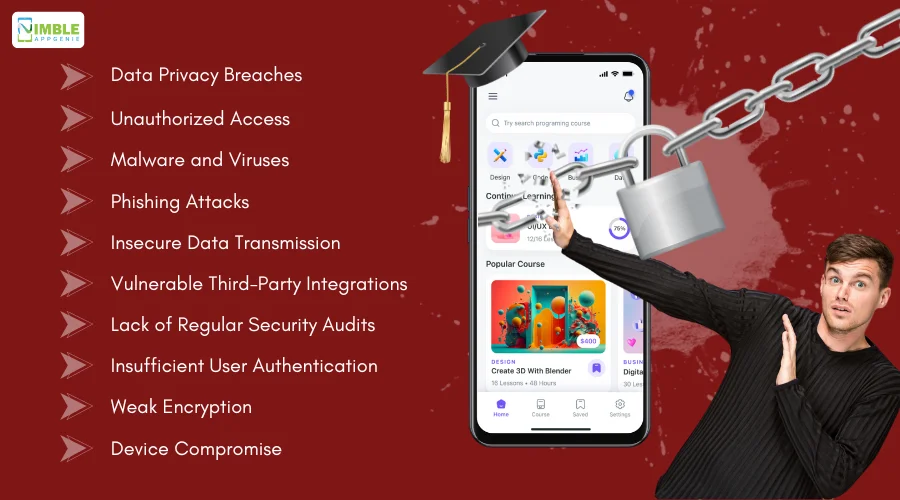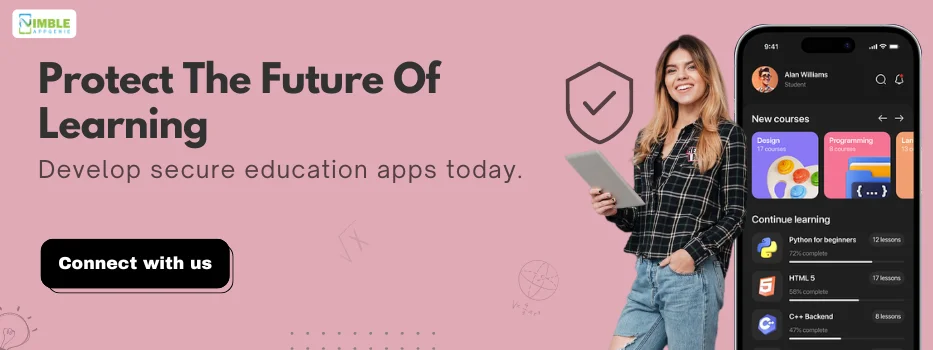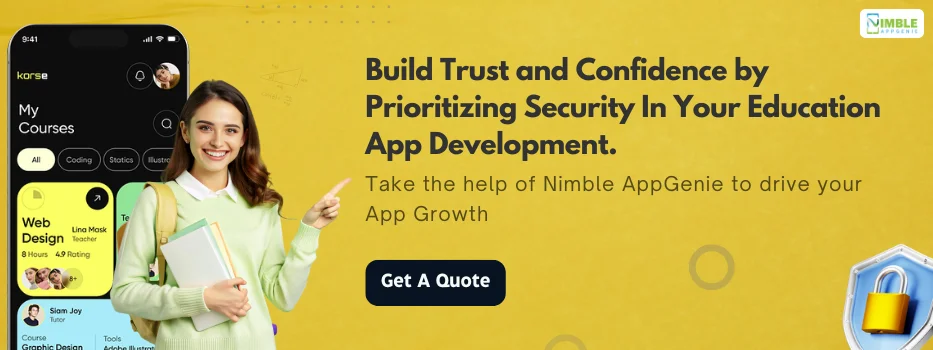Education Apps have become necessary tools to connect for students and teachers.
However, the increasing reliance on these applications has also increased the potential security questions of user information. From safeguarding sensitive student data to preventing disruptions to learning, education app security is paramount.
With the explosion of connected devices and the growing complexity of cyber threats, ensuring the integrity and privacy of educational platforms is a huge challenge in front of developers as well as investors.
As per a report, the education sector has become a prime target for cyber-attacks. It is also believed that a staggering 87% of educational institutions have fallen victim to cyber-attacks.
In this blog, we will share the critical security question for education app developers and stakeholders, exploring the complicated landscape of eLearning app security and potential mitigation strategies.
What Are Security and Privacy In Education Apps?
Security in education apps refers to the protection of the app itself and the data it processes from unapproved access, use, disclosure, disruption, modification, or destruction.
It involves safeguarding sensitive information like student data, financial information, and more. On the parallel side, privacy in education apps focuses on the right of every individual to control their personal information.
It ensures that data is collected, used, and shared lawfully, fairly, and transparently. Privacy also involves protecting students’ sensitive information from misuse and unauthorized access.
In essence, security is about protecting the app and its data, while privacy is about protecting the individuals whose data is being processed. Both are essential for building the trust of users on the app.
Several threats are lurking out:
- Data leakage.
- Unauthorized Access.
- Malware
- SQL Injection
- Insecure Authentication.
These might look like just names to you, but one attack can potentially damage your app. This represents the increasing importance of robust mobile app security.
Security Risks of Education Apps
Are you wondering “What are the security risks of education apps?”
Well, Education Apps collect a lot of sensitive information from student’s personal information to financial one.
This data can be misused by attackers and can be considered an important educational app development challenge that shouldn’t be overlooked.
Here are some of the common risks:

1. Data Privacy Breaches
Education App gathers a lot of sensitive student data, including personal information and academic records.
If not securely protected, this data can be exposed to unauthorized individuals, leading to identity theft, financial loss, or reputational damage for the school and students.
Unfortunately, if a breach occurs then it will result in tarnishing the image of your educational app, this is why emphasis on data privacy is important.
2. Unauthorized Access
Unauthorized access is when someone gains entry to a system or data without the owner’s permission.
Education apps may contain valuable intellectual property like curriculum materials and assessment tools.
Weak access controls can allow unauthorized individuals to steal or misuse the information, compromising the app’s integrity and the school’s resources. Simply, it’s a security breach where someone who shouldn’t be there gets in.
3. Malware and Viruses
Turning your education app idea into a reality is complex. Especially, knowing that education apps can be a path for malware and viruses.
These malicious programs can damage devices, steal your data, or disrupt user learning activity, creating a negative impact on your educational app students, teachers, and the school’s IT infrastructure.
4. Phishing Attacks
Phishing tactics especially deceptive links came out as the most common tactic, resulting in nearly 36% of all attacks.
Cybercriminals often use phishing to trick users into revealing sensitive information.
Education Apps are targets for these attacks, as they can be used to steal login credentials, personal data, or financial information from students, teachers, and administrators.
5. Insecure Data Transmission
Insecure data transmission poses one of the significant risks of education apps.
Education Apps convey sensitive data including student grades and personal information; this can be intercepted and misused if transmitted without proper encryption.
Compromised data can delay educational processes, disrupt learning, and eat away at trust between students, parents, and educational institutions. It’s surely a big development mistake of an educational app that you shouldn’t overlook.
6. Vulnerable Third-Party Integrations
Third-party integrations, while enhancing an education app’s feature such as incorporating video conferencing tools can also introduce a challenge to the security of education apps.
In case, these third-party protocols, it can compromise the entire app’s ecosystem. For example, integrating a poorly secured video conferencing platform can expose a lot of data to unauthorized access, while a compromised content repository could lead to data breaches or malware access.
This underscores the need for security audits and ongoing monitoring of third-party integrations to safeguard the sensitive information handled by education apps.
7. Lack of Regular Security Audits
Do you want to keep your app secure? Then, you can’t ignore regular security audits as it is the foundation of a robust security posture.
By neglecting these assessments, organizations risk leaving vulnerabilities undetected. This oversight can lead to important consequences, including data breaches, financial loss, and reputational damage.
Furthermore, proactive audits help identify weaknesses, allowing for appropriate mitigation and avoiding potential attacks.
8. Insufficient User Authentication
Insufficient user authentication is a huge security risk for education apps.
Weak password policies, lack of multi-factor authentication, and the absence of account lockout mechanisms can leave student and institutional data exposed.
This not only compromises privacy but also disrupts the learning process as academic resources and progress become vulnerable to tampering. This is why focusing on education app security should be your utmost priority.
9. Weak Encryption
Another growing issue in education apps is weak encryption.
Meaning, that if you are developing an education app the data should be safe at transit and at rest.
If that’s not the case, then weak encryption of your app can cause a lot of damage and also make it easier for attackers to decrypt data, leading to data breaches.
10. Device Compromise
Device compromise raises a huge security risk for education apps.
With the rise of online learning, students often access sensitive academic and personal information through their devices.
Education apps rely on the security of the devices they run on. Say, if a device is compromised, malicious actors can potentially intercept or steal data, leading to identity theft, academic fraud, or unauthorized access to learning platforms.
This not only jeopardizes student privacy but also undermines the integrity of the educational process.
These are some of the well-known security risks of education apps. We hope you understand how not having good security in your app can cost you a lot. Let’s get to know about the ways to take care of your app.
How to Strengthen Your Education App Security?
After hearing a lot about these education app securities, it’s time to take a look at ways to improve or overcome security issues.
Let’s get to know all about them:

-
Robust Encryption
One of the necessary ways to secure your education app is to have strong encryption. This encryption is supreme for safeguarding sensitive student data and strengthens app security.
Employ advanced encryption algorithms to protect information like personal details, academic records, and payment information. This ensures data remains confidential and doesn’t get compromised.
-
Multi-Factor Authentication
Implement multi-factor authentication to boost account security.
Requiring multiple forms of verification such as passwords, biometric authentication or codes significantly reduces the risk of unauthorized access.
MFA creates a robust barrier against unapproved access. This helps users to enjoy the benefits of educational software without the constant worry of personal information falling into the wrong hands.
-
Regular Security Audits
The purpose of educational software is to facilitate learning and enhance teaching experiences, but security can be a huge issue.
So, it’s important to conduct thorough security audits and vulnerability assessments regularly. These evaluations help identify and address potential weaknesses in the app’s infrastructure and code, preventing exploitation.
-
Secure Code Development
Adhere to strict secure coding practices to minimize vulnerabilities in the app’s code.
Rigorous adherence to secure coding practices is essential to strengthen an app against vulnerabilities.
By implementing robust coding standards and conducting thorough code reviews and testing, developers can proactively identify and eliminate potential security flaws.
This diligent approach meaningfully reduces the risk of exploitation and safeguards user data.
-
Comprehensive User Education
Empowering users with cyber security knowledge is crucial.
Comprehensive education for students, teachers, and parents is essential. By teaching them to create strong, unique passwords, recognize phishing attempts, and report suspicious activities.
We can significantly reduce the risk of social engineering attacks and protect sensitive data.
-
Robust Incident Response Plan
A robust incident response plan is important for education app security.
By outlining clear procedures for containing the damage, informing affected students, parents, and educators, and restoring the usual learning environments. Besides that, AI in education can help a lot including threat detection and response tools that can accelerate incident handling.
Regular plan updates, incorporating emerging threats and best practices in the eLearning landscape, are essential for effective response.
-
Continuous Monitoring and Threat Detection
Monitoring and Threat Detection is important for safeguarding eLearning platforms.
Implementing advanced systems to identify and respond to emerging threats in real-time is crucial. Staying informed about the latest cyber security trends ensures proactive protection against growing attacks.
By combining human expertise with AI-driven analytics, organizations can effectively mitigate risks and maintain a secure learning environment.
-
Legal and Regulatory Compliance
Staying updated on the ever-changing landscape of data privacy and security regulations is vital. You can regularly assess your eLearning platform to identify compliance gaps and potential risks.
Comprehensive documentation of security practices and compliance efforts not only demonstrates a commitment to data protection but also aids in efficient audits and incident response.
Nimble AppGenie: Your Education App Solution Partner
If you want unparalleled education app security expertise, you can take the help of Nimble AppGenie, a market-leading Education App Development Company.
With a track record of safeguarding sensitive student data, we provide robust encryption, advanced threat detection, and rigorous compliance adherence.
Our commitment to excellence ensures your app meets the highest security standards, fostering trust and confidence among parents, educators, and students alike.
Conclusion
The landscape of education apps is rapidly evolving, presenting both immense opportunities and significant security challenges. Safeguarding student data, protecting intellectual property, and maintaining user trust are vital for the success of any education app.
By implementing robust security measures, staying updated on the latest threats, and fostering a culture of security awareness, developers and institutions can create a secure and enriching learning environment. Additionally, cultivating a security-conscious culture among users, from students to administrators, is essential to prevent breaches and maintain data integrity.
By adopting a proactive and holistic approach to security, the education sector can harness the full potential of technology while ensuring a safe and secure learning environment.
FAQs
Data breaches remain the most prevalent security threat, often resulting from weak authentication, phishing attacks, or insecure data transmission.
Prioritize data minimization, employ strong encryption, and adhere to relevant data privacy regulations. Transparency and user consent are also crucial.
Regular security audits help identify vulnerabilities, assess compliance, and prevent breaches. They are essential for maintaining a secure app.
Implement robust malware detection and prevention measures, regularly update software, and educate users about the risks of downloading suspicious files or clicking on unknown links.
User education empowers individuals to recognize and avoid security threats. It helps prevent phishing attacks, unauthorized access, and other social engineering tactics.

Niketan Sharma is the CTO of Nimble AppGenie, a prominent website and mobile app development company in the USA that is delivering excellence with a commitment to boosting business growth & maximizing customer satisfaction. He is a highly motivated individual who helps SMEs and startups grow in this dynamic market with the latest technology and innovation.
Table of Contents






No Comments
Comments are closed.